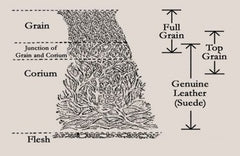How We Make Great Leather Guitar Straps
There's a lot of confusion out there about leather products and the quality of different types of leather. So I thought it would be cool to take a minute and explain what goes into making great leather guitar straps.
We are big advocates of the old recording engineer's adage, "Crap in; crap out." As it goes in the studio, so it goes with leather guitar straps. That's why we use full-grain leather in all of our straps, and on all of the end tabs for our woven straps.
 But what does "full-grain" leather even mean? Basically this means it's the leather closest to the surface of the hide. As you go inward and closer to the animal's flesh, the quality of the leather quickly declines. As a consumer, it's helpful to know the difference between types of leather because marketers will attempt to confuse you with these terms. Whether you're buying a guitar strap or shoes, the same rules apply.
But what does "full-grain" leather even mean? Basically this means it's the leather closest to the surface of the hide. As you go inward and closer to the animal's flesh, the quality of the leather quickly declines. As a consumer, it's helpful to know the difference between types of leather because marketers will attempt to confuse you with these terms. Whether you're buying a guitar strap or shoes, the same rules apply.
Basic Types of Leather
Full-Grain
This is the best stuff. It comes from the outermost layer of the hide and it's the most beautiful, supple, and strong. How the leather is treated and dyed at the tannery is also important to the final finish. We work with the Horween leather tannery in Chicago for our Skinny Leather Strap and the end tabs on our Indian guitar strap. Horween is one of the finest leather tanneries in America, and it shows in their product. On our Peruvian strap, we use full-grain leather from Guanjuato in Mexico, an area of Mexico renowned for their leather goods.
Top-Grain
This is a step down from Full-Grain. It might pull from some of the same parts of the hide as full-grain leather, but it won't be as supple and feel as nice as Full-Grain. Top-Grain leather is strong, but it's not as soft and pliable as Full-Grain. For some rugged purposes, like a gun holster or saddle, top grain might work just fine. But on products like guitar straps it won't fly because comfort is an important factor.
Genuine Leather
We're getting much closer to the cow's flesh now. You can heavily treat genuine leather and use it to make some products like baseball gloves. But we'd never use it to make a guitar strap. This is also what suede is made from. Unlike the baseball glove, suede is just genuine leather that hasn't been smoothed out at the tannery. Suede works great for some things, but it's not very durable or tough.
Bonded Leather
Not sure that we should really call this leather. It's really the plywood of leather products. It might look like leather in the photo, but it's basically a bunch of cheap leather scraps ground up, glued together, painted with polyurethane, and finished to look like leather. In reality it's more like plastic or vinyl.
Beware of Marketing Jargon
No matter what type of leather good you're looking to buy, these basics are always the same. A lot of the marketing terms that you'll hear around leather—Italian leather, upholstery leather, etc.—are actually just ways of describing what the tannery does, or how the leather is treated and dyed after coming off the cow. They can really do a lot of good for the product at the tannery, but remember, if you put crap into the tannery, you'll get crap out. That's what we rock full-grain leather in Original Fuzz products.
Hopefully this breakdown of the common types of leather will help you out as a consumer. Feel free to shoot us an email if you have more questions. If you'd like to go deeper into the rabbit hole, here's a great thread from StyleForum.net.

The Skinny Leather Strap in action with a Fender Strat

Detail of the Fuzz logo embossed into the Horween leather end tab on The Indian Strap

